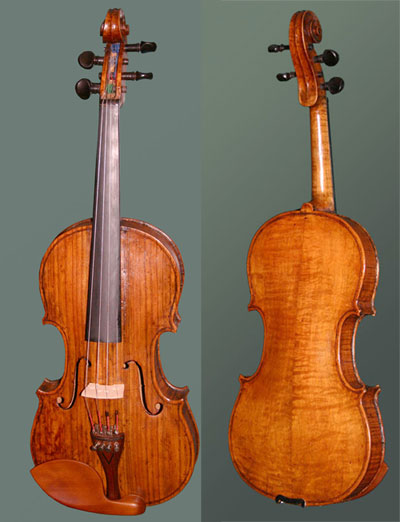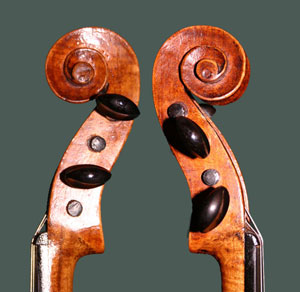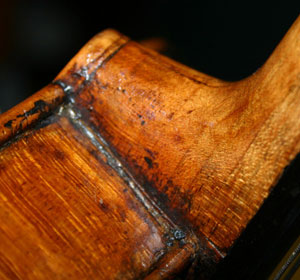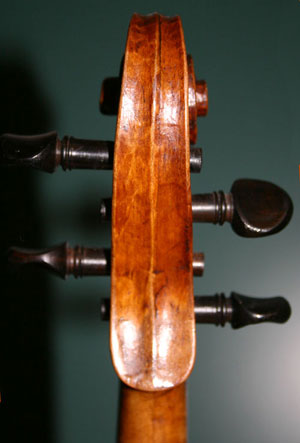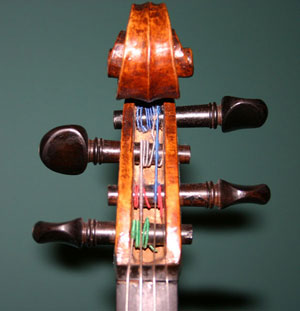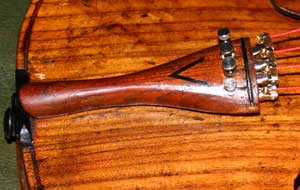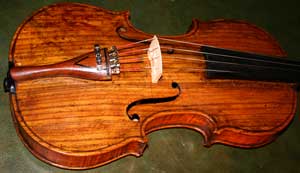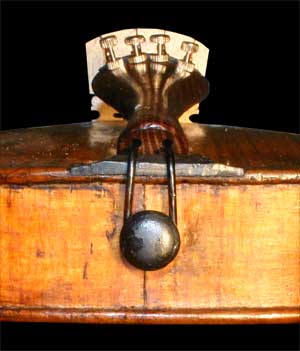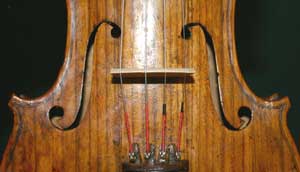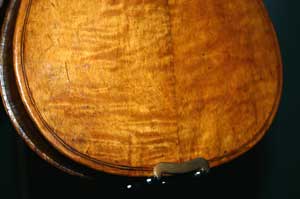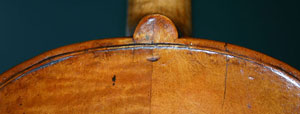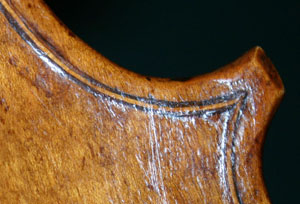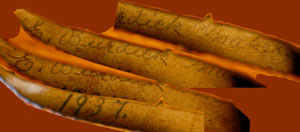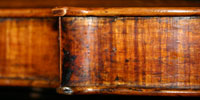Violin by E. Burdick, 1937
Described by Dwight Newton, Mewzilk.com organologist.
In 2005 I found an interesting amateur-made fiddle which I purchased from a seller in Nicholasville, Kentucky. He said he got it from someone in Richmond who said it came from "eastern Kentucky." There is writing in pencil visible through the f-hole that says:
E. Burdick Maker 1937
This is all I know of its provenance.
I believe the fingerboard, pegs and bridge are all recent replacements. I added the boxwood chinrest myself.
Dr. Terry Conners, wood identification expert with the University of Kentucky College of Forestry, has identified the top of this violin as butternut (juglans cinerea), sometimes called "white walnut," a species once common throughout the northeastern US to Tennessee, but now becoming endangered due to a fungus disease. One is immediately struck by the appearance of this violin because of the wide striped grain of the top.
I had not heard of using butternut for violins, but apparently this was not unheard of. There is a diary entry from 1875 by Noah S. Grindle of Vigo County, Indiana (near Terre Haute):
"Sunday [June] 13, 1875—Clear & cool. Was with Milo Gauge all AM in woods hunting for butternut fork for violin top. Found none that would answer the purpose. Rained in after part of night. To wet to plow."
It's not clear why one would seek a "fork" for a top. This presumably refers to a tree with a double trunk. Perhaps it was considered desirable to have a wide board with the naturally joined trees instead of split, bookmatched and rejoined boards as is the usual case. This would be a way to get a wide quarter-sawn board.
In any case, this fiddle does not appear to be made from a butternut fork, but the two pieces do not join in the center, but rather just to the right of the bridge. In fact, the top of the right f-hole cuts through the seam. There is some distortion along the seam towards the top end that may have been a badly repaired separation.
The saddle appears to be maple that has been painted to look like ebony. The neck and back are maple. I have not yet decisively determined the material on the sides.
The tailpiece is Osage orange (maclura pomifera, known locally as horse apple, hedge apple, or bodark). This is an extremely hard wood from the South and Southwest. Osage normally has a lot of twists and knots and the sapwood and heartwood are often unusable. So it is not often used for finished cabinetry or sawn lumber. Because of its density and resinous grain it is virtually impervious to moisture and insects and has historically has been used for fence posts. The Native Americans used this wood for excellent bows, but it is very difficult to find a good length of it and then to work it, so only the best bow makers would use it. However, small pieces of good wood can easily be found in an otherwise gnarly log, making it ideal for small parts requiring strength and hardness. I have seen other country fiddles with Osage saddles and nuts. There is an inlaid black wood chevron shape that may be intended to prevent plitting, or could just be decorative. I am tempted to make a matching Osage chin rest for it.
The woodworking on this fiddle is generally quite good with some interesting exceptions. The neck and head, for some reason, has a seam down the middle, being apparently made of two halves. The neck grain is subtly quilted, but there is no compelling reason I can see to bookmatch it. The scroll is a bit lopsided when seen from the back, though the left and right aspects are reasonably symmetrical and it looks only a little crooked from the front. The purfling is not flush in several places and has some odd splices, but the corners are relatively accurate. The arching of the top and back is skillfully done and the f-holes are fairly graceful and clean.
The most obvious issue is the instrument's rather horrible varnish job. The finish is a gloppy, uneven mess with fingerprints and dirt embedded in it. I like to think this is not original, but may rather have been a botched attempt to refinish it. The neck is also varnished and some extends sloppily over the fingerboard and end pin. If the fingerboard and fittings are not original, this would support the theory that the varnish is also not original. I am tempted to have the instrument re-finished. It's a matter of deciding what is truest to the maker's hand.
The tone of the fiddle is full, but not too bright or intense, which I find pleasing.
UPDATE: C.D. Burdick Violin
A correspondent from Winston-Salem, North Carolina, has contacted me about a hand-made violin by one C.D. Burdick in the 1880s. It seems likely that the makers of his violin and mine are related. See my page relating to his instrument. Further analysis will be done to find an unequivocal relationship if there is one.

Updated 12/14/2006
